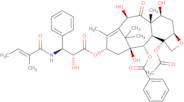
10-Deacetyl cephalomannine
CAS: 76429-85-1
Ref. 3D-FD20817
| 1mg | 189,00 € | ||
| 2mg | 239,00 € | ||
| 5mg | 448,00 € | ||
| 10mg | 569,00 € | ||
| 25mg | 1.017,00 € |
Produktinformation
- 10-Deacetylcephalomannine
- 10-Deacetyltaxol B
- 10β-Deacetylcephalomanine
- 7,11-Methano-1H-cyclodeca[3,4]benz[1,2-b]oxete, benzenepropanoic acid deriv.
- Benzenepropanoic acid, α-hydroxy-β-[(2-methyl-1-oxo-2-butenyl)amino]-, 12b-(acetyloxy)-12-(benzoyloxy)-2a,3,4,4a,5,6,9,10,11,12,12a,12b-dodecahydro-4,6,11-trihydroxy-4a,8,13,13-tetramethyl-5-oxo-7,11-methano-1H-cyclodeca[3,4]benz[1,2-b]oxet-9-yl ester, [2aR-[2aα,4β,4aβ,6β,9α[αR*,βS*(E)],11α,12α,12aα,12bα]]-
- Benzenepropanoic acid, α-hydroxy-β-[[(2E)-2-methyl-1-oxo-2-buten-1-yl]amino]-, (2aR,4S,4aS,6R,9S,11S,12S,12aR,12bS)-12b-(acetyloxy)-12-(benzoyloxy)-2a,3,4,4a,5,6,9,10,11,12,12a,12b-dodecahydro-4,6,11-trihydroxy-4a,8,13,13-tetramethyl-5-oxo-7,11-methano-1H-cyclodeca[3,4]benz[1,2-b]oxet-9-yl ester, (αR,βS)-
- Benzenepropanoic acid, α-hydroxy-β-[[(2E)-2-methyl-1-oxo-2-butenyl]amino]-, (2aR,4S,4aS,6R,9S,11S,12S,12aR,12bS)-12b-(acetyloxy)-12-(benzoyloxy)-2a,3,4,4a,5,6,9,10,11,12,12a,12b-dodecahydro-4,6,11-trihydroxy-4a,8,13,13-tetramethyl-5-oxo-7,11-methano-1H-cyclodeca[3,4]benz[1,2-b]oxet-9-yl ester, (αR,βS)-
- benzenepropanoic acid, alpha-hydroxy-beta-[[(2E)-2-methyl-1-oxo-2-buten-1-yl]amino]-, (2aR,4S,4aS,6R,9S,11S,12S,12aR,12bS)-12b-(acetyloxy)-12-(benzoyloxy)-2a,3,4,4a,5,6,9,10,11,12,12a,12b-dodecahydro-4,6,11-trihydroxy-4a,8,13,13-tetramethyl-5-oxo-7,11-methano-1H-cyclodeca[3,4]benz[1,2-b]oxet-9-yl ester, (alphaR,betaS)-
10-Deacetyl cephalomannine is a taxane derivative that has been isolated from the needles of Taxus cuspidata. This compound is metabolized by human liver enzymes, such as cytochrome P450, to 10-deacetyltaxol (10-DT). 10-DT has shown antitumor activity in vitro and in vivo against human cancer cell lines. It also inhibits the growth of Mycobacterium tuberculosis in culture. The mechanism of action for this compound is not known, but it may inhibit protein synthesis or cell division. 10-DT inhibits the growth of cancer cells by binding to tubulin and inhibiting microtubule polymerization.
Chemische Eigenschaften
Technische Anfrage zu: 3D-FD20817 10-Deacetyl cephalomannine
Wenn Sie ein Angebot anfordern oder eine Bestellung aufgeben möchten, legen Sie stattdessen die gewünschten Produkte in Ihren Warenkorb und fordern Sie dann ein Angebot oder eine Bestellung an aus dem Warenkorb. Es ist schneller, billiger und Sie können von den verfügbaren Rabatten und anderen Vorteilen profitieren.





